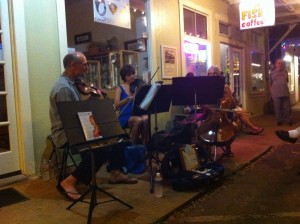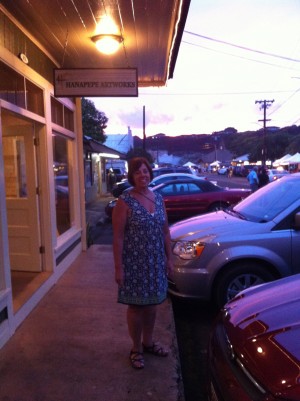
Classical trio, Hanapepe, Kaua’i.
Friday night in Hanapepe, Kaua’i, Hawai’i. The little town was once the home to the bloodiest labor dispute in Kaua’i history (the September 9, 1924 “Hanapepe Massacre” wherein striking Filipino sugar cane workers clashed with police, resulting in twenty deaths on both sides of the dispute). The old town portion of Hanapepe is ablaze in light, its shops and galleries and eateries open for business until 9:00pm, its sidewalks packed with additional food and craft and trinket vendors, discordant sounds of classical, Hawaiian, folk, blues, rock, and country music echoing from Bert’s Auto Repair on the south end of the drag to the Talk Story Bookstore on the north. Rene’ and I and the McVeans, Ron and Nancy, our tour guides for our first trip to the Garden Island (actually, our first trip to any Hawaiian island) stroll into Art Night in Hanapepe, an event that occurs every Friday night in this small hamlet amidst the crumbling buildings and ruined dreams of immigrants. Maybe that’s too harsh a portrait of old Hanapepe town. There’s charm here, whether you are a car junky, like my buddy Ron, who finds Bert’s endlessly beguiling, or my wife, the artist, who could spend the rest of her life pondering the genius of other painters, sculptors, and artisans in the myriad galleries and shops. The place is, despite the ugly decay of the Aloha theater looming above it all like a pillar of diminished prosperity, alive with visitors and locals alike, young, old, and all ages in between.

Main street, Hanapepe, Art Night.
We haoles (white people; visitors to the islands) separate and wander the singular street the festival is confined to, stopping to listen to good or bad music (there are plenty of both), to gawk at good and bad art (the same), and to eventually find a bite to eat from one of the sidewalk vendors. Rene’ opts for a freshly baked chicken pot pie. I leave her in line and totter off, my scarlet red skin, once a badge of honor in my spring-break-in-Daytona-days now a mark of an aging, clueless tourist, in search of more authentic island fare. I find a wagon selling teriyaki beef with Hawaiian side staples: cold macaroni salad and white rice. I order my food, buy Rene’ a bottle of water, and wait. And wait. And wait. Island time. The meals aren’t pre-cooked and stored on a hot plate. Each meal is started as it is ordered, making for fresh, succulent beef, but very long, restaurant-like delays. When my name is called, the young lady serving me apologizes. The white rice that comes with the dish is still cooking.
“Another ten to fifteen minutes, OK?”
I shake my head.
“How ’bout we substitute another scoop of macaroni for the rice?”

Rene’ at Art Night.
“OK.”
“I put some extra beef in, because you wait so long…”
In between leaving my wife and ordering my food, I’d made a quick detour to cross the famous swinging bridge of Hanapepe ( where I was nearly run over by some island kids skate boarding the fragile span with glee: they were, in their devilment, extremely polite, saying “excuse me sir” as they zipped past me in the dark).
I make it back to where my friends and my wife are eating freshly baked native cherry pie under a cloudy but dry night sky. As I open my meal container, I’m pleasantly surprised. The young lady has piled on the teriyaki soaked prime rib to the limits of the styrofoam lid.
“This is good.”
After downing my meal, I walk across the street to the western most bookstore in America, Talk Story Books, just to say hello. The four of us had been in the store two days earlier, on our way back from Waimea Canyon. I’d asked one of the owners, Cynthia, if they had The Tattoo by Hawaiian author Chris McKinney. I’d read The Queen of Tears, one of McKinney’s later novels I’d picked up in our hotel’s gift shop and liked the story and writing.
“I’m not familiar with his stuff.”
I’d smiled and handed Cynthia one of my Cloquet River Press business cards.
“I know the feeling. I’m a writer who suffers from the same disease,” I’d said through a smile. “Any suggestions as to a good novel on Hawaii? And not Michner. I’ve read Michner.”
The store owner had padded off and returned with Hotel Honolulu by Paul Theroux. I had nodded, accepted the book, and looked some more.

Cynthia greeting customers inside Talk Story.
Tonight, as I step onto the front steps of the bookstore, Cynthia sees me and extends her hand.
“I’m liking the Theroux.”
“I remember. I thought you would.”
She returns to her other customers. I resist the urge to venture inside the bookstore and buy another book in an attempt to help one of the surviving independent bookstores in its battle with Amazon. I don’t go in. I still have the Theroux and Jack London’s Stories in Hawaii to get through. I find Rene’ and the McVeans. We find empty seats in front of a trio of classical musicians and listen to Vivaldi and other familiar composers for a bit as the streets empty, vendors pack up their EZ-UPs, and the festival winds down.
The sky is dark as our rental car speeds south to Lihue. I’m soon asleep in the back seat.

Talk Story
Aloha.
Mark


